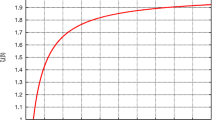Abstract
We examine the combinatorial requirements of topology-transparent transmission schedules in a mobile ad hoc network (MANET). Specifically, if each of the N nodes has at most D active neighbors, we require the schedule to guarantee a collision-free transmission to each neighbor. This requirement is met by a cover-free family. We show that existing constructions for topology-transparent schedules correspond to an orthogonal array. Moreover, we show that Steiner systems support the largest number of nodes for a given schedule length. Both of these combinatorial objects are special cases of cover-free families. Analytically and numerically, we examine slot guarantees, expected throughput, and normalized expected throughput for systems of small strength, exploring the sensitivity of the response to D. Expected throughput provides a better performance metric than the minimum throughput results obtained earlier. The impact of a more realistic model of acknowledgments is also examined. The extension of the schedule to multiple frames returns us to the orthogonal arrays. The very density of Steiner systems that afforded an improvement over orthogonal arrays in one frame impedes the best extension to more frames.
Similar content being viewed by others
References
IEEE Standard 802.11: Wireless LAN Medium Access Control and Physical Layer Specifications, December (1999).
R. J. R. Abel, F. E. Bennett and G. Ge, The existence of four HMOLS with equal sized holes, Des. Codes Crypt., Vol. 26 (2002) pp. 7–31.
R. J. R. Abel and A. C. H. Ling, Some new constructions for (v, 5, w*, 1) PBDs, J. Combin. Math. Combin. Comput., Vol. 32 (2000) pp. 97–102.
F. E. Bennett, C. J. Colbourn and R. C. Mullin, Quintessential pairwise balanced designs, J. Stat. Plann. Infer., Vol. 72 (1998) pp. 15–66.
M. Benveniste, G. Chesson, M. Hoeben, A. Singla, H. Teunissen and M. Wentink, Enhanced distributed coordination function (EDCF), In IEEE Working Document 802.11–01/131r1, March (2001).
I. Chlamtac and A. Faragó, Making transmission schedules immune to topology changes in multihop packet radio networks, IEEE/ACM Transactions on Networking, Vol. 2, No. 1, February (1994) pp. 23–29.
I. Chlamtac, A. Faragó and H. Zhang, Time-spread multiple-access (TSMA) protocols for multihop mobile radio networks, IEEE/ACM Transactions on Networking, Vol. 5, No. 6, December (1997) pp. 804–812.
I. Chlamtac and S. Pinter, Distributed node organization algorithm for channel access in a multi-hop packet radio network, IEEE Transactions on Computers, Vol. 36, No. 6 (1987) pp. 728–737.
C. J. Colbourn and J. H. Dinitz, (eds), The CRC Handbook of Combinatorial Designs, CRC Press, Inc., Boca Raton, FL (1996).
C. J. Colbourn, J. H. Dinitz and D. R. Stinson, Applications of combinatorial designs to communications, cryptography, and networking. In J. D. Lamb and D. A. Preece (eds.), Surveys in Combinatorics, 1999, London Mathematical Society, Lecture Note Series 267, Cambridge University Press (1999) pp. 37–100.
C. J. Colbourn, V. R. Syrotiuk and A. C. H. Ling, Steiner systems for topology-transparent access control in MANETs. In Proceedings of the Second International Conference on Ad Hoc Networks and Wireless (AdHoc Now'03), Montreal, Quebec (2003) pp. 247–258.
D.-Z. Du and F. K. Hwang, Combinatorial Group Testing and its Applications, World Scientific Publishing Co. Pte. Ltd., second edition (2000).
A. D'yachkov, V. Rykov and A. M. Rashad, Superimposed distance codes, Problems Control and Information Theory, Vol. 18 (1989) pp. 237–250.
P. Erdös, P. Frankl and Z. Füredi, Families of finite sets in which no set is covered by the union of r others, Israel J. Math., Vol. 51 (1985) pp. 79–89.
A. S. Hedayat, N. J. A. Sloane and J. Stufken, Orthogonal Arrays, Theory and Applications, Springer-Verlag, Inc., New York, NY (1999).
J.-H. Ju and V. O. K. Li, An optimal topology-transparent scheduling method in multihop packet radio networks, IEEE/ACM Transactions on Networking, Vol. 6, No. 3, June (1998) pp. 298–306.
A. D. Myers, V. R. Syrotiuk and G. Záruba, An adaptive generalized transmission protocol for mobile ad hoc networks, ACM/Kluwer Journal on Mobile Networks and Applications (MONET), Vol. 7 (2002) pp. 493–502.
L. Romdhani, Q. Ni and T. Turletti, AEDCF: Enhanced service differentiation for IEEE 802.11 wireless ad-hoc networks, Technical Report 4544, INRIA (2002).
M. Ruszinkó, On the upper bound of the size of the r-cover-free families, Journal of Combinatorial Theory, Series A, Vol. 66 (1994) pp. 302–310.
J. L. Sobrinho and A. S. Krishnakumar, Quality-of-service in ad hoc carrier sense multiple access wireless networks, IEEE Journal on Selected Areas in Communications, Vol. 17, No. 8, August (1999) pp. 1352–1368.
D. R. Stinson, R. Wei and L. Zhu, Some new bounds for cover-free families, Journal of Combinatorial Theory, Series A, Vol. 90 (2000) pp. 224–234.
V. R. Syrotiuk, C. J. Colbourn and A. C. H. Ling, Topology-transparent scheduling in MANETs using orthogonal arrays, In Proceedings of the DIALM-POMC Joint Workshop on Foundations of Mobile Computing, San Diego, CA (2003) pp. 43–49.
V. R. Syrotiuk, Wireless medium access control protocols, In (A. Boukerche and I. Chlamtac, eds.), Handbook on Algorithmic Aspects of Wireless Networks, CRC Press, (to appear).
Waterloo Maple Inc., Maple 8. http://www.maplesoft.com/main.html
R. Zheng, C.-J. Hou and L. Sha, Asynchronous wakeup for ad hoc networks, Proceedings of the Fourth International Conference on Mobile Ad Hoc Networking & Computing (Mobihoc03), Annapolis, MD, June 1–3 (2003) pp.35–45.
C. Zhu and S. Corson, A five-phase reservation protocol (FPRP) for mobile ad hoc networks, In Proceedings of 17th Annual Joint Conference of the IEEE Computer and Communication Societies (INFOCOM'98), San Francisco, CA, March 29–April 2 (1998) pp. 315–321.
Author information
Authors and Affiliations
Rights and permissions
About this article
Cite this article
Colbourn, C.J., Ling, A.C.H. & Syrotiuk, V.R. Cover-Free Families and Topology-Transparent Scheduling for MANETs. Designs, Codes and Cryptography 32, 65–95 (2004). https://doi.org/10.1023/B:DESI.0000029213.74879.e0
Issue Date:
DOI: https://doi.org/10.1023/B:DESI.0000029213.74879.e0




